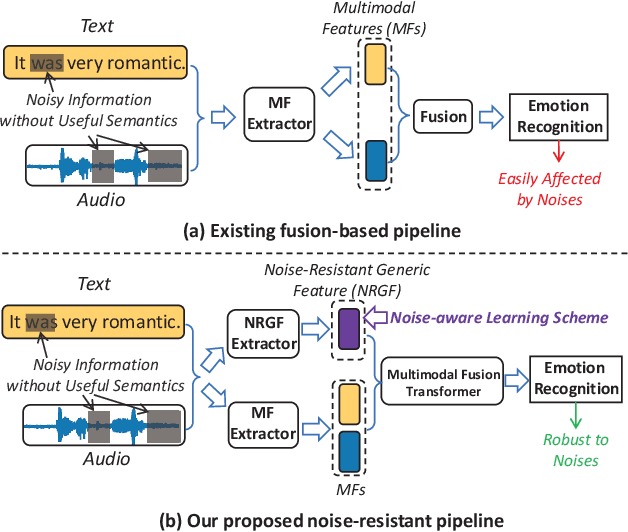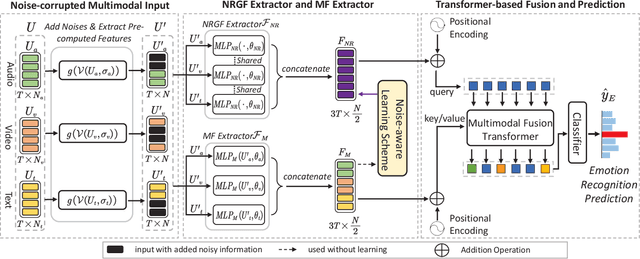Zijing Chen
Smile upon the Face but Sadness in the Eyes: Emotion Recognition based on Facial Expressions and Eye Behaviors
Nov 19, 2024



Abstract:Emotion Recognition (ER) is the process of identifying human emotions from given data. Currently, the field heavily relies on facial expression recognition (FER) because facial expressions contain rich emotional cues. However, it is important to note that facial expressions may not always precisely reflect genuine emotions and FER-based results may yield misleading ER. To understand and bridge this gap between FER and ER, we introduce eye behaviors as an important emotional cues for the creation of a new Eye-behavior-aided Multimodal Emotion Recognition (EMER) dataset. Different from existing multimodal ER datasets, the EMER dataset employs a stimulus material-induced spontaneous emotion generation method to integrate non-invasive eye behavior data, like eye movements and eye fixation maps, with facial videos, aiming to obtain natural and accurate human emotions. Notably, for the first time, we provide annotations for both ER and FER in the EMER, enabling a comprehensive analysis to better illustrate the gap between both tasks. Furthermore, we specifically design a new EMERT architecture to concurrently enhance performance in both ER and FER by efficiently identifying and bridging the emotion gap between the two.Specifically, our EMERT employs modality-adversarial feature decoupling and multi-task Transformer to augment the modeling of eye behaviors, thus providing an effective complement to facial expressions. In the experiment, we introduce seven multimodal benchmark protocols for a variety of comprehensive evaluations of the EMER dataset. The results show that the EMERT outperforms other state-of-the-art multimodal methods by a great margin, revealing the importance of modeling eye behaviors for robust ER. To sum up, we provide a comprehensive analysis of the importance of eye behaviors in ER, advancing the study on addressing the gap between FER and ER for more robust ER performance.
Open-Set Video-based Facial Expression Recognition with Human Expression-sensitive Prompting
Apr 26, 2024Abstract:In Video-based Facial Expression Recognition (V-FER), models are typically trained on closed-set datasets with a fixed number of known classes. However, these V-FER models cannot deal with unknown classes that are prevalent in real-world scenarios. In this paper, we introduce a challenging Open-set Video-based Facial Expression Recognition (OV-FER) task, aiming at identifying not only known classes but also new, unknown human facial expressions not encountered during training. While existing approaches address open-set recognition by leveraging large-scale vision-language models like CLIP to identify unseen classes, we argue that these methods may not adequately capture the nuanced and subtle human expression patterns required by the OV-FER task. To address this limitation, we propose a novel Human Expression-Sensitive Prompting (HESP) mechanism to significantly enhance CLIP's ability to model video-based facial expression details effectively, thereby presenting a new CLIP-based OV-FER approach. Our proposed HESP comprises three components: 1) a textual prompting module with learnable prompt representations to complement the original CLIP textual prompts and enhance the textual representations of both known and unknown emotions, 2) a visual prompting module that encodes temporal emotional information from video frames using expression-sensitive attention, equipping CLIP with a new visual modeling ability to extract emotion-rich information, 3) a delicately designed open-set multi-task learning scheme that facilitates prompt learning and encourages interactions between the textual and visual prompting modules. Extensive experiments conducted on four OV-FER task settings demonstrate that HESP can significantly boost CLIP's performance (a relative improvement of 17.93% on AUROC and 106.18% on OSCR) and outperform other state-of-the-art open-set video understanding methods by a large margin.
Noise-Resistant Multimodal Transformer for Emotion Recognition
May 04, 2023



Abstract:Multimodal emotion recognition identifies human emotions from various data modalities like video, text, and audio. However, we found that this task can be easily affected by noisy information that does not contain useful semantics. To this end, we present a novel paradigm that attempts to extract noise-resistant features in its pipeline and introduces a noise-aware learning scheme to effectively improve the robustness of multimodal emotion understanding. Our new pipeline, namely Noise-Resistant Multimodal Transformer (NORM-TR), mainly introduces a Noise-Resistant Generic Feature (NRGF) extractor and a Transformer for the multimodal emotion recognition task. In particular, we make the NRGF extractor learn a generic and disturbance-insensitive representation so that consistent and meaningful semantics can be obtained. Furthermore, we apply a Transformer to incorporate Multimodal Features (MFs) of multimodal inputs based on their relations to the NRGF. Therefore, the possible insensitive but useful information of NRGF could be complemented by MFs that contain more details. To train the NORM-TR properly, our proposed noise-aware learning scheme complements normal emotion recognition losses by enhancing the learning against noises. Our learning scheme explicitly adds noises to either all the modalities or a specific modality at random locations of a multimodal input sequence. We correspondingly introduce two adversarial losses to encourage the NRGF extractor to learn to extract the NRGFs invariant to the added noises, thus facilitating the NORM-TR to achieve more favorable multimodal emotion recognition performance. In practice, on several popular multimodal datasets, our NORM-TR achieves state-of-the-art performance and outperforms existing methods by a large margin, which demonstrates that the ability to resist noisy information is important for effective emotion recognition.
 Add to Chrome
Add to Chrome Add to Firefox
Add to Firefox Add to Edge
Add to Edge